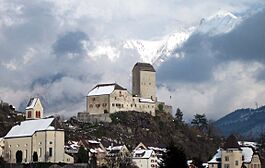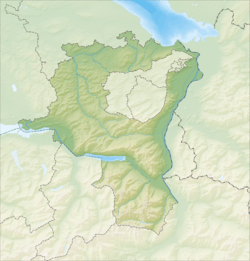Sargans facts for kids
Quick facts for kids
Sargans
|
||
|---|---|---|
 |
||
|
||
| Country | Switzerland | |
| Canton | St. Gallen | |
| District | Wahlkreis Sarganserland | |
| Area | ||
| • Total | 9.46 km2 (3.65 sq mi) | |
| Elevation | 480 m (1,570 ft) | |
| Population
(Dec 2020 )
|
||
| • Total | 6,213 | |
| • Density | 656.8/km2 (1,701.0/sq mi) | |
| Postal code |
7320
|
|
| Surrounded by | Balzers (LI), Fläsch (GR), Mels, Vilters-Wangs, Wartau | |
Sargans is a town in Switzerland. It is located in the canton of St. Gallen. Sargans is part of the Sarganserland area.
The town is famous for its castle. This castle was built even before Switzerland became a country in 1291. Sargans was also once a "County" (a type of region ruled by a count) within the Holy Roman Empire.
Contents
History of Sargans
Sargans has a very long history. People lived here as far back as the Stone Age. Later, a large Roman farm was destroyed around the year 270.
In the early Middle Ages, Sargans was part of a region called Lower Raetia. Over time, people speaking German languages slowly replaced those who spoke Rumantsch. A church was mentioned here in the 800s.
Sargans became part of the Werdenberg region in the 1100s. A special branch of the Werdenberg family, called Werdenberg-Sargans, started in the late 1200s. The castle was likely built in the 1100s and was first written about in 1282. The town of Sargans grew up around this castle in the 1200s.
The name Sargans has changed over time. In the 1000s, it was called Senegaunis. Later, it became Sanegans and Sangans. The name Santgans was used in the 1300s. The way we spell Sargans today started in the 1500s. No one is sure where the name comes from. Some people think it might be linked to the word for "goose" (Gans in German).
Around 1406, the town and castle were made stronger with new walls. In 1445, the Swiss Confederacy captured and burned the town, but not the castle.
In 1483, the count of Werdenberg-Sargans had to sell the area to the Swiss Confederacy. From then until 1798, the castle was used by Swiss leaders. The town burned down again in 1490. In 1501, Sargans was officially given city rights and the right to hold a weekly market.
The town's coat of arms, which shows a goose, has been used since the 1400s. This design comes from the old idea that the name Sargans was linked to the word for "goose."
In 1798, Sargans became part of the Mels district. It joined the Canton of St. Gallen in 1803. Most of the town was destroyed by fire in 1811.
Sargans became an important railway hub in the 1800s. Train lines connecting to Chur, Zürich, and Lake Constance were built in 1859. A line to Vienna was added in 1884. The Saar river was changed to help build the railway station and later for motorways. Sargans did not have many factories. The local iron ore mine closed in 1966.
Geography of Sargans
Sargans covers an area of about 9.5 square kilometers (3.7 square miles). About 38% of this land is used for farming. Forests cover about 35% of the area. Around 20% of the land has buildings or roads. The rest is made up of rivers or lakes.
The town is the main center of the Sarganserland region. It sits at the bottom of Mount Gonzen. The Rhine river forms the eastern border of Sargans, next to Liechtenstein. Because it is located where the Rhine and Seez valleys meet, Sargans has always been important for travel and trade. The town includes the main village of Sargans and smaller areas called hamlets. These include Vild, Ratell, Prod, Splee, Riet, Farb, Töbeli, and Schwefelbad.
Transportation in Sargans
Sargans is a very important place for travel in the region. It is located on the A3 motorway. Trains going north to St. Gallen, east to Chur and Ticino, and towards Austria all pass through Sargans. Buses also leave Sargans for Liechtenstein.
People and Population
Sargans has a population of about 6,400 people. Around 22% of the people living in Sargans are from other countries. Most people in Sargans speak German (about 87%). Other languages spoken include Serbo-Croatian and Italian.
The population of Sargans has grown by about 7% over the last ten years.
In Sargans, about 11% of the population are children aged 0-9. Teenagers aged 10-19 make up about 12% of the population. Most adults (aged 20-59) make up about 56% of the population. Older people (60 and above) make up about 20% of the population.
Many people in Sargans live in families. About 53% of households are couples with children. Around 23% are couples without children. About 13% of people live alone.
When it comes to education, about 68% of adults (aged 25-64) in Sargans have finished high school or gone on to higher education like university.
Here is how the population of Sargans has changed over time:
| year | population |
|---|---|
| 1800 | 680 |
| 1850 | 907 |
| 1900 | 931 |
| 1950 | 2,075 |
| 1960 | 2,571 |
| 1970 | 4,058 |
| 2000 | 4,765 |
Religion in Sargans
Based on a census from 2000, most people in Sargans are Roman Catholic (about 63%). About 17% belong to the Swiss Reformed Church. There are also smaller groups of people who belong to the Orthodox Church or other Christian churches. About 5.5% of the population is Islamic. Around 4.5% of people do not belong to any church.
Economy of Sargans
Sargans has a healthy economy. In 2007, the unemployment rate was low, at 1.75%.
The town's economy is divided into three main parts:
- Primary sector: This includes jobs like farming. About 79 people work in this area.
- Secondary sector: This includes jobs like manufacturing and building. About 1,171 people work in this area.
- Tertiary sector: This includes jobs in services, like shops, offices, and healthcare. About 1,791 people work in this area.
Many people who live in Sargans also work in the town. However, many residents travel outside Sargans for work. Also, many people travel into Sargans from other places to work.
Important Heritage Sites
Sargans has two important historical sites. The old mining operation and Schloss Sargans (Sargans Castle) are both listed as important Swiss heritage sites.
Notable People from Sargans
- Josef Anton Henne (1798–1870): A Swiss historian and politician who was active when modern Switzerland was being formed.
- Alexander Hug (born 1975): A Swiss ski mountaineer who lives in Sargans.
Weather in Sargans
Sargans usually has about 142 days of rain or snow each year. On average, it gets about 1325 millimeters (52 inches) of rain or snow annually.
The wettest month is August, with about 153 millimeters (6 inches) of rain or snow. It rains or snows for about 14 days in August. June has the most days of precipitation (about 14.5 days), but with slightly less rain or snow overall. October is the driest month, with about 82 millimeters (3.2 inches) of precipitation over 14.3 days.
Images for kids
See also
 In Spanish: Sargans para niños
In Spanish: Sargans para niños









